In order for the metal roof to serve for a long time and look attractive, it is necessary to correctly fasten the profiled sheet to the wooden crate. This requires a competent selection of fasteners and adherence to the scheme for their installation.
Lathing for corrugated board and lathing step
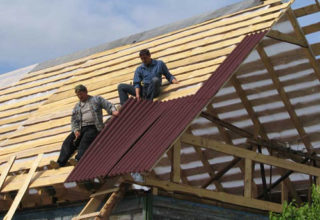
Before fixing the corrugated board on the roof with self-tapping screws, you will need to fix the crate. It is made of wood impregnated with a composition that prevents damage to the material under the influence of moisture. It is necessary to process the planks, as condensation often accumulates under the roof.
During work, it is important to observe the prescribed spacing values between adjacent elements. If low planks (3.5 cm) are used, the distance should not exceed 0.5 m with a small angle of inclination (up to 15 degrees) and 1 m - with a more pronounced one. For elements of 6 cm, a distance of no more than 3 m is supposed, for elements of 7 cm - up to 4 m.
Do not forget about the arrangement of the ventilation lumen. To make it, you need an additional lathing made of rafters or metal purlins.
Characteristics and brands of corrugated board
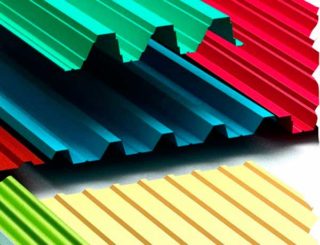
The material in question is made from thin rolled metal (usually steel) and is produced in the form of sheets with a profile in the form of waves. The thickness of the profiled sheet varies from 0.3 to 1 mm. The corrugation can be trapezoidal or rounded. The ratios of dimensions for the flooring are regulated by technical standards.
Due to its combination of thinness and rigidity, the material is widely used for roofing. A zinc coating or a polymer film is applied to the sheets to protect them from corrosion processes, exposure to sun rays and precipitation. Most often polyester is used for this purpose. Sometimes it is combined with Teflon - this combination better protects the sheet from weather factors.
The highest class polymer coating - PVDF with polyvinyl chloride. The material has some features that distinguish it from metal tiles. First, it can be mounted on a pitched roof that has a slight slope (11 degrees or less). Secondly, it has the same profile throughout the section.
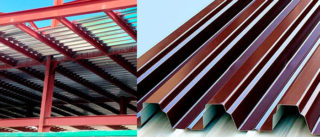
On sale you can find the following grades of professional sheet:
- Thin wall (marked with the letter C) - used for the installation of fences and undemanding awnings. Such material is not suitable for the roof because of the risk of deformation under the weight of ice and snow masses.
- Load bearing (H) - high strength and thick, well suited for roofing.
- NS - medium in fineness, intermediate between the two previous types. It can be screwed to the roof surface if there is not a lot of snow in the region in winter.
Following the letter denoting the grade of the material, there is a number indicating the height of the product in millimeters. When buying, it is important to check the compliance of the specified parameters with the real data of the sheets, as well as the absence of indentations, scratches and other surface damage.
So that the material does not lose its performance, it is also important to understand how to properly screw the profiled sheet onto the roof.
Laying rules
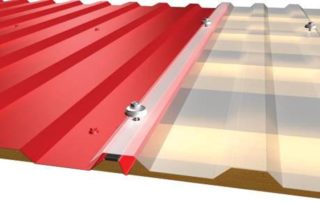
It is necessary to tighten the fasteners according to a certain scheme, designed to preserve the strength of the roof.
Work instructions:
- The process starts from the bottom left corner. The first sheet is laid with a projection of 20-30 mm and an allowance of 150 mm for the next row.
- The upper row is placed on the lower one to prevent moisture from entering the joints.
- Bottom pieces are attached to each sole that touches the batten structure. To avoid beveling, the material is leveled relative to the cornice. The middle sections are fixed with a checkerboard with a step every two waves. The tops of the final row, adjacent to the ridge area, are attached through a wave.
- The horizontal overlap will be at least 0.1 m, and its value is the less, the greater the slope of the roof.
- In slightly inclined slopes (less than 15 degrees), all butt joints are coated with a sealant with silicone.
- All sheets are first attached to the battens. The remaining screws are screwed in with a checkerboard so that the distance between the fasteners is no more than 0.5 m.
- Additional components are fastened with long parts (5-9 cm), the distance between them can be up to 30 cm.
- A ridge profile is mounted in the slope joints. It is fixed with self-tapping parts in each of the waves. The ridge is needed to protect the area under the roof from water ingress and to increase the rigidity of the structure. They begin to lay it from the end opposite to the dominant wind. Under the shoulders, seal pads are mounted, having contours similar to those of the profile.
In order to properly fasten the corrugated board to the roof with self-tapping screws, you need to figure out whether to install them in the upper or lower wave. Manufacturers indicate the second option, but among the masters there are also supporters of the first.
With bottom mounting, the sheets are securely attached to the crate, but the joints are often exposed to moisture running along the slopes. If the installation of corrugated board is carried out by professionals, you can safely apply this method. Otherwise, it is permissible to fix them in the upper wave.
Since the material is lightweight, the roof covered with it is characterized by high windage. It is subject to significant wind loads. Because of this, it is recommended to make the distance between the screws small - a maximum of 0.5 m.
Selection of self-tapping screws
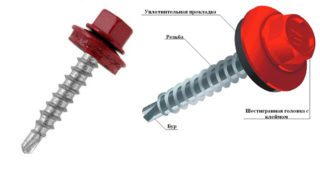
For roofs made of corrugated board, special fasteners are required, made of high-carbon steel and covered with a galvanized layer. One of their design features is the front-mounted drilling section. Thanks to this structure of the element, you can drill the material to be attached directly while screwing the part. Another special feature is the special washer with a plastic lining. The self-tapping screw head has the shape of a hexagon and the size of M8. There is a manufacturer's mark on the front part.
Decking is usually not fastened with simple screws for a number of reasons. Firstly, they do not sit firmly enough on thin metal surfaces, which is why the sheets cannot be installed on a metal profile. Secondly, the structural features of the screws play a role: they do not have a sufficient width of the washer. Because of this, under the influence of alternating loads, the profiled sheet quickly wears out in the connection areas. It can get to the point that the flooring elements come off the base.
Also, the method with screws is not suitable, since the holes for them must be drilled in advance. Because of this, the strength of the connection decreases and additional time is spent on installation work. Finally, screwing in the fasteners destroys the protective substances with which the profiled sheets are processed. To protect them from moisture ingress, self-tapping screws of a special design are needed, equipped with special gaskets under the washers.
Features of fastening screws
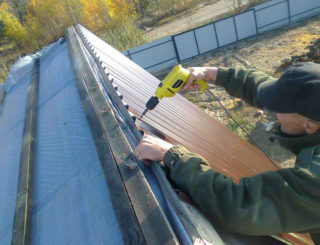
Before fixing the profiled sheet on the roof, you need to pay attention to a number of recommendations. Failure to comply with the technology leads to a decrease in the quality of the finished flooring.
Common mistakes include:
- Excessive tightening of self-tapping screws. In this case, an excessive load is created on the spacers located under the washers. As a result, they begin to crack and easily allow moisture to pass through. This is especially dangerous when installing fasteners in the bottom wave.
- The opposite is insufficient twisting. It is also fraught with the ingress of liquid into places where the integrity of the coating is broken - the sealing rubber lining does not come into contact with the surface of the profiled sheet.
- Insufficient or excessive drill thickness. In the first case, damage to the thread or other section of the fastening element is possible. In the second, there is a lack of sealing and a deterioration in the bearing capacity.
In areas not characterized by increased snowiness, profiled sheets with the marking CH45 or CH35 are usually used for arranging the pavement. The length of the fasteners for them depends on where they will be installed. For example, when installing a self-tapping screw into the groove of the profiled sheet, a short nail (2 cm) is sufficient. If the self-tapping screw is installed in the overlap area, its length should be at least 5 cm. The same applies to fixing the ridge strip through the flooring. Sometimes even longer fasteners are used for this (this depends on the structure of the roof).
For snowy areas, profiled metal of the H60 or H75 brand is best suited.
To tighten the screw elements, a screwdriver is used, equipped with an option to control the tightening force. The part is placed in the recess strictly at right angles to the plane of the profiled sheet. Do not allow the surface to bend inward. In the event of a misalignment, the fastener must be removed (unscrewed from the plane), and a cork made of wood must be driven into the hole (for this, PVA-M glue is used). Then the same screw must be mounted according to the rules.
When 2-3 months have passed after the initial procedure for installing the screws, you need to check and tighten them. This will prevent loosening of the roof structure and increase the duration of its service.
Number of screws per square meter
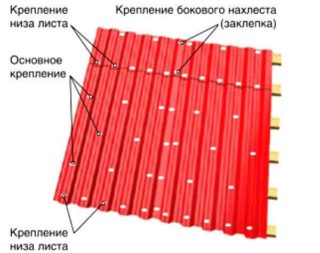
The number of fasteners per unit area is determined by a number of factors: the thickness of the final coating, the characteristics of the profiled sheet, the structure of the roof. The minimum number is taken as 8 fasteners per square meter of area. Half of them will be of medium length (3.5 cm), and two self-tapping screws of 2 and 5 (or more) cm each. Knowing the area of the roof to be treated, you can thus calculate the total number of screws that you need to purchase. In practice, fewer of them will be required due to the fact that the material is laid with an overlap, however, you should not buy a number of parts inferior to the calculated one. After all, construction work is often accompanied by the loss of fasteners.
Most often, parts are sold in packages that indicate their number.









If you screw the self-tapping screw into the bottom of the wave, you will never get rid of the roof leakage, do not learn from your mistakes! Each subsequent summer season, you will have leaks in different places, the guarantee is 101%. Screw the screws only into the top of the wave, there will not be any movement of the sheet, and the lever can be excluded simply, screw in the required number of screws, that's all!
For the ninth season I have been working with corrugated board all the screws in the bottom of the wave. More than a dozen roofs (single-pitched, multi-pitched, hipped roofs) have been covered. There have never been any leaks or complaints. The main thing is to do according to the rules and neatly. Moreover, these are recommendations from manufacturers and professionals with whom I had to deal.
It all depends on your imagination . I was also told it will flow, all the nonsense, how can it flow if you have a washer on the roof. The roof was covered 6 years ago and does not drip. All Moscow dachas have been doing this for decades.
the wind has more chances to rip off the roof, which happens if you never fix it tightly at the top of the wave, just like slate out of habit, the roof at the bottom of the wave has not been leaking for more than one year, the roofer confuses something, read about camping, and gazebos, dear, but where did physics go, at high temperatures the wave is playing, (thermal expansion, but at the bottom of the wave it is not so susceptible, here Alex is right
Not when you hear, not when it does not twist the screws into the upper wave, the sheet will not hold and will fly off over time, since there is a gap between the iron and the board that will not allow you to effectively hold the sheet.
Igor, continue to cover the roofs according to the slate principle ... In the course of this, the roofs “fly”….
You can do this and that.
This is how long the self-tapping screw should be to screw it into the top of the wave? with washers, rubber or silicone plus metal, and screw only into the bottom of the wave, otherwise you will not squeeze.
Not a single roof has been built, both from metal tiles and from corrugated board, with different angles of the slope, well, not one does not flow, all the screws are only down the waves. it makes no sense to twist to the top of the wave, since there will be no hard pressure, and if so, then the fasteners will constantly loosen, breaking the hole, or it will run or at a fine moment the roof will fly away. Yes, and at small angles there is a need to clean the roof of snow here and the heads of the screws will interfere.
I screw the self-tapping screw down the waves, and at the junction with the next sheet into the upper wave in order to press the joint.
Before you start covered with a roof, ask the master a question. If you answer as Igor., Immediately dosvidos, so as not to suffer !!!
The builders strengthened the mountain in the lower wave. In the spring, water bubbles poured out of pneumatics on the ceiling, and the workshop is large. Though they were warned. Stupid to hit the bottom. Loads on the sheet, snow. The fasteners will play. Temperature difference. Again sheet play. As a result, the extraction of the self-tapping screw, the drying of the seal, and half a millimeter of the gap for leakage is enough. Only in the upper wave, if you don't want to redo everything.
That's right, if there is no lathing, it will be so, all the more, the workshop is large - the girders are probably also large, and the roof can fly away, for this, the lathing is made, and here is the result for you, modern prof. the sheet has a thickness of 0.5 mm and it will never give a strong connection through the top of the wave, and the sheet itself will warp when the self-tapping screw is tightly tightened, Yes, by the way, the screws do not hit, they are screwed in, and he makes himself a hole in the profiled sheet practically no gap, plus 2 washers.
right alex and alexander, I also have so many roofs with corrugated board and nothing, everything is fine
Due to the fact that you have a flat roof, it is better to twist to the top of the wave, just do not tighten too much, the manufacturer does not recommend it because of the laying of self-tapping screws and it was not necessary to take a large wave it is easier to put the crate more often